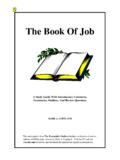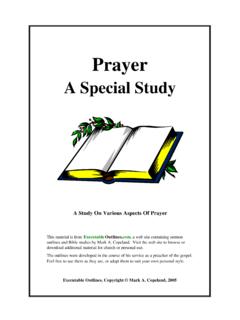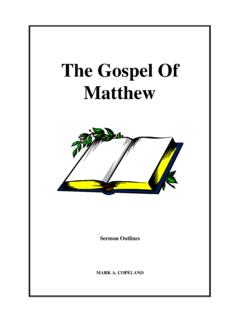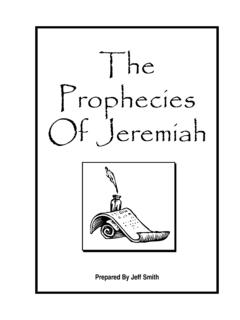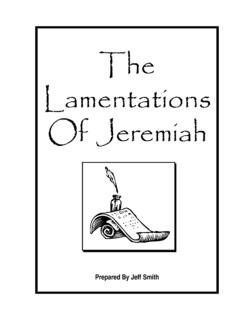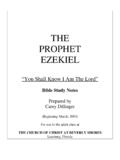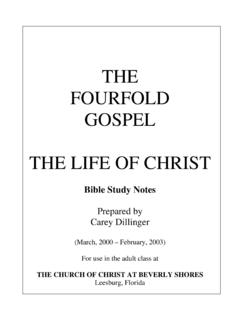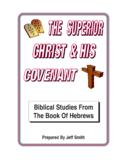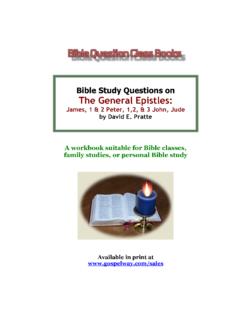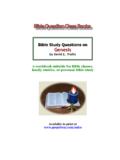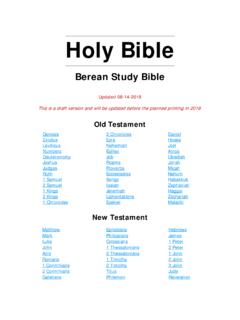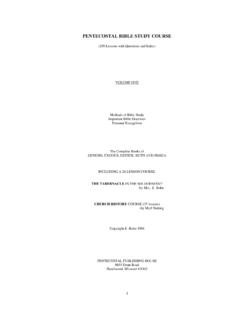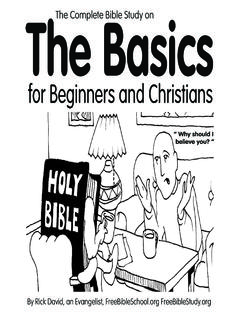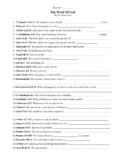Transcription of Parables of Jesus - Bible Study Guide
1 Parables of Jesus A Thirteen Lesson Bible Class Study a Study of the Parables of Jesus , our Teacher by Smith Introduction The Parables of Jesus are among the greatest and most picturesque lessons in all his ministry. One must remember that the intent of the Parables is always just beneath the surface of the story and not be overwhelmed with what is on the surface. The Parables were used to hide deeper knowledge from those unprepared for it. While they became lost in the surface of the teaching, true disciples could delve deeper and learn better how to walk with Christ. Syllabus Lesson 1 The Nature of Parables Introduction to the subject Lesson 2 The Gospel Seed Sower of Seeds, Mustard Seed, Growing Seed Lesson 3 The Worth of the Kingdom Hidden Treasure, Pearl of Great Price, Lost Coin Lesson 4 What About Others? Salt, Lamp Under A Basket, Leaven, Lost Sheep, Good Samaritan Lesson 5 Blessed Are The Merciful Unforgiving Servant, Creditor and Debtors, Barren Fig Tree Lesson 6 Count The Cost Friend In Need, Building A Tower and Making War, Persistent Widow Lesson 7 Humility Prodigal Son, Pharisee and Tax Collector Lesson 8 A New Name New Wineskins, Wicked Vine Dressers, Great Supper Lesson 9 Sure Foundation Building a House, Workers in the Vineyard, Two Sons Lesson 10 Preparation Fig Tree, Wise and Foolish Virgins, Absent Householder, Rich Fool, Faithful and Evil Servants Lesson 11 Separation Tares, Dragnet, Wedding Feast Lesson 12 Stewardship Ten Talents, Faithful and Wise Steward, Unjust Steward, Unprofitable Servants, Minas Lesson 13 Review Lesson 1.
2 The Nature of Parables The Bible , like any piece of literature, employs a number of figures of speech, including allegories and metaphors. But, the most striking figure used is the parable, for it teaches such deep and timeless lessons. A parable is not a fable, like those made famous by Aesop ( Androcles and the Lion). The fable is primarily an earthy lesson while the parable seeks to teach a heavenly and spiritual truth. Nor is a parable a myth like the Greek stories touching the unexplained. A parable occupies a loftier realm than these. The Greek word for our parable is paraballo ( ), a compound of two very vivid words. The first part is para- which means beside or alongside. The second part is -ballo, which means to throw. So, to teach by parable is literally to throw a lesson alongside the true object of the doctrine. The teacher illustrates this by describing t h a t.
3 In his great work, Notes on the Parables of Our Lord, Trench says, Each one of the Parables is like a casket, itself of exquisite workmanship, but in which jewels richer than itself are laid up; or like fruit, which however lovely to look upon, is yet more delectable in its inner sweetness (page 15). The disciple that sits at the feet of Jesus , then or now, is curious and hungry to open that casket or peel that fruit to reveal the rich and sweet treasure somewhat hidden within. Of course, that brings up an important question as well. Why did Jesus use Parables in the first place? Why not just reveal everything plainly and without hyperbole? Thankfully, the Lord answers our query himself. Matthew 13 is a chapter filled with Parables and in the midst of them, he explains their worth (verses 10-13): And the disciples came and said to Him, Why do you speak to them in Parables ?
4 He answered and said to them, Because it has been given to you to know the mysteries of the kingdom of heaven, but to them it has not been given. For whoever has, to him more will be given, and he will have abundance; but whoever does not have, even what he has will be taken away from him. Therefore I speak to them in Parables , because seeing they do not see, and hearing they do not hear, nor do they understand. Certain people had already rejected Jesus without considering the evidence from their hearts. As he goes on to say, they were the fulfillment of Isaiah's prophecy concerning a dull-hearted people whose spiritual lethargy had rendered them unable to learn and unconcerned about ignorance. Because of this malaise, people like the scribes and Pharisees could not see Jesus nor ever understand his truths. The central focus of most Parables was the kingdom that the Messiah was establishing.
5 He wanted his disciples to know what it would be like. Most misunderstood the nature of the coming kingdom, thinking it to be a physical realm headquartered in Jerusalem with the Messiah on its golden throne. In fact, Jesus was talking about a spiritual kingdom, not of this world, one composed of all races and not just one. His kingdom was established on the first Pentecost after his resurrection and he was seated upon its throne in heaven (Acts 2:29-33). That kingdom is the church. Most of the Parables have to do with the church that Jesus said he would build after Peter's confession in Matthew 16:18. In studying the Parables , one must remember to look deeper than the surface for the true lesson. For instance, the parable of laborers in the vineyard is not about wage equity but God's mercy. But, one must also remember that not every detail in a parable will be significant; some will be incidental.
6 _____. The Parables of Jesus 1. 1. What is the difference between a fable and a parable? A parable teaches a heavenly, spiritual message, while a fable teaches an earthly one. 2. What is the Greek word for parable and what does it mean? Paraballo literally means to throw alongside and describes the method of teaching this by recounting a story from nature or society. 3. How is a parable like a beautiful casket or a tantalizing piece of fruit? While the package is inviting, its contents are far more exquisite and valuable. 4. What should this teach us about studying Parables ? We should not get bogged down on the surface like the outsiders, but look deeper for the spiritual lesson Jesus intended. 5. From what kind of hearts was Jesus obscuring his teaching in Parables ? From those with dull hearts, unexercised in spiritual investigation and openness to truth that crushes long held opinions.
7 6. What is the central focus of most of Jesus 's Parables ? The kingdom he was establishing. 7. What was the general misunderstanding about this focused thing? That it was to be an earthly kingdom of Jews only headquartered in Jerusalem. 8. Was Jesus able to establish this objective before he was crucified or did he fail? He established the kingdom of prophecy by creating his body, the church. 9. In the Study of Parables , which is most important: the surface story on earthly matters or the hidden lesson on spiritual concerns? The hidden lesson is of infinitely more value than any surface lesson. 10. Is the parable of the prodigal son about a farmer raising two boys out in the country or something deeper? If something deeper, what is it? This parable is about God's extension of mercy to all the penitent who would return to him. 11. Who does the father in that parable represent?
8 Who does the prodigal son represent? The father is God and the son is every man. _____. 2 Smith Lesson 2: The Gospel Seed Bible Texts For This Lesson Sower of Seeds Matthew 13:3-23, Mark 4:2-20, Luke 8:4-15. Mustard Seed Matthew 13:31-32, Mark 4:30-32. The Growing Seed Mark 4:26-29. An agrarian economy prevailed in the world from its creation until the industrial revolution in the nineteenth century. It was a very simple thing for Jesus to do to look from his pulpit out to the fields around him and notice a farmer here and a vineyard tender there. The farmer and his seed provided the Lord with an exceptional teaching illustration regarding the growth of his kingdom. His apostles continued the familiar refrain throughout their New Testament epistles. In dealing with the budding sectarianism at Corinth, Paul compared the work of men and God to laboring in the field: I planted, Apollos watered, but God gave the increase.
9 So then neither he who plants is anything, nor he who waters, but God who gives the increase. Now he who plants and he who waters are (1 Cor. 3:6-8). The apostle was not trying to steal any credit for himself nor cause the brethren to heap commendation upon any other man. Rather, it was God who provided for the bounty in the barn. Man must sow the seed and nurture it in the soil, but ultimately he can do nothing to force it to grow. Christians are to broadcast the gospel seed, spreading it right and left and straight ahead as they traverse the land in their everyday lives. They themselves are to receive the implanted word, which is able to save your souls. Saints should think of the gospel as seed like they would buy at the store to prepare a vegetable of flower garden. Seed does no good while still in the package, but maintains its potential indefinitely.
10 Seed, taken from the packet and scattered on the soil can bring forth fruit. The apostle Peter further identifies the gospel message as life-giving seed, adding that Christians are .. born again, not of corruptible seed, but incorruptible, through the word of God while lives and abides forever, because All flesh is as grass, And all the glory of man as the flower of the grass. The grass withers, And its flower falls away, But the word of the Lord endures forever.' Now this is the word which by the gospel was preached to you (1 Peter 1:23-25). A tomato seed will lead to a beautiful green vine which will blossom and give its red fruit. Later, it will wither and die. Not so, the gospel seed. It grows lush, flowers and bears fruit forever. Someone sowed the seed in your heart; now share the blessing, Peter reminds us. That great gospel seed maintains its sway in the hearts of the devoted, for John writes, Whoever has been born of God does not sin, for His seed remains in him; and he cannot sin, because he has been born of God (1 John 3:9).
